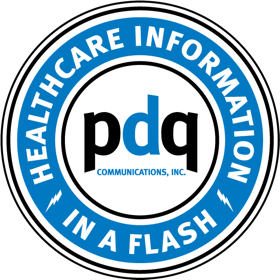When introducing a new product or service, how can you ensure users are moving toward the...
When it comes to connecting with healthcare professionals (HCPs), email marketing remains a preferred method for its convenience, cost, and effectiveness.
HCPs are notoriously busy, and often bombarded with marketing emails and messaging from competing brands. Reliably connecting with your healthcare audience can be a challenge, since they are constantly on the move and require quick solutions to specific needs.
So how do you ensure your email campaigns will be informative, personal, and relevant, while still resonating with your audience in a way that moves them through the buyer’s journey?
Incorporate these 15 best practices into your HCP email marketing strategy.
1. Segment Your Audience
Segmentation is a potent strategy, enabling you to divide your contact list into groups based on specific criteria and use it to craft engaging messaging that resonates with a particular audience.
In fact, 78% of marketers report subscriber segmentation is the most effective strategy for email marketing campaigns, according to a recent compilation of survey statistics by inbound marketing and sales enablement platform HubSpot.
For example, email content for a cardiologist would differ from that targeting an orthopedic surgeon, reflecting their distinct specialties. Other segmentation variables include location, prescribing habits, intra-specializations一emergency medicine versus emergency medicine/anesthetics, for example一and more.
Research which emails your segments are opening and clicking, and use those insights to further modify your messaging and deployments. For example, if certain subscribers are gravitating toward campaigns specifically advertising new medications, then you’ll want to consider creating a segmented list based on that.
2. Keep It Concise and Useful
HCPs don't have time to sift through lengthy emails to find the main point. Anything you send should offer value with educational and informative content. With only eight seconds to capture your reader’s attention, cutting self-promotional fluff and extra words is a must.
To forge that initial connection with your prospects, include a vendor-neutral resource or reference material. You could choose to cite this within your marketing information or offer it as a download.
If you’re targeting a pediatrician, it could be a research report on a new medication for children and adolescents. If dentists are within your realm, consider offering a content piece on a dental-specific topic. An HCP prospect is more likely to convert if provided with useful information that’s immediate and relevant to their practice area.
3. Include Actionable Requests
Every marketing email you send should include a clear call to action (CTA) that motivates your audience to do something.
Still, many companies make the mistake of including too many (or not enough) CTAs. These cause distractions, and might result in your offer being overlooked. Placing your CTA in a prominent spot, such as above the fold, will yield more clicks.
Avoid general wording such as “Click Here” or “Enter Now.” Instead, let the prospect know what they’re receiving: “Download This Case Study” or “Read the Article.”
Adding specific dates or time stamps, such as “Offer Ends at Midnight” or “Don’t Miss this One-Time Event” helps increase engagement. This sense of urgency can trigger a fear of missing out, leading to quicker responses.
4. Ensure Your Campaigns Are Personalized
Personalization is a proven tactic in email marketing. Personalized, relevant messaging conveys a sense of community and familiarity to potential customers. In a recent HubSpot study, a whopping 94% of marketers surveyed say personalization boosts sales.
Adding the subscriber’s name or a callout to their location helps increase engagement. Instead of addressing the email “Dear Customer,” consider adding specific “To” and “From” elements. The recipient sees the email is intended for them, and it’s being sent by an actual person—not a mass, auto-generated mailing. It also shows you have taken time to learn more about their company, products, and services.
If your prospects are interacting with middle-of-the-funnel content, provide messaging and offers personalized for that buyer’s journey stage. Once the prospect has converted to a customer, highlight specific, previously ordered products to more accurately help them in the future.
5. Stay Up to Date on Marketing Tools and Tactics
If the last few years have taught the healthcare marketing industry anything, it’s the importance of staying informed and pivoting your strategy when necessary.
Keeping up with healthcare and marketing industry news and trends helps you increase the effectiveness of individual campaigns, and your overall email strategy, in the long term.
This will become increasingly important as the industry continues to double down on prioritizing digital marketing strategies and adopting new technologies such as machine-learning AI to improve email targeting, messaging, and deployments.
Remember to take stock of any tools or strategies you’re currently utilizing. If your campaign can use a boost, it’s wise to consult a professional for insights and strategies on the latest email marketing trends and tactics.
6. Implement AI, Carefully
AI is a powerful tool for email marketing, but must be used thoughtfully. A recent survey found 95% of marketers who use generative AI for email creation rate it as “effective,” with 54% calling it “very effective.” With the right prompts and careful review, generative AI will streamline your email creation process, while helping deliver impactful results.
However, it's crucial to ensure AI-generated content remains accurate, relevant, and personalized to your audience.
7. Use Video Marketing
Video is a powerful way to communicate your message. It entertains and informs subscribers, leading to a solid return on investment.
According to email automation platform Mailchimp, benefits include quicker subscriber engagement and high adoption rates, especially on mobile devices. This helps target HCPs, who as aforementioned, are already short on time. Removing any barriers to engaging with this audience is key.
Video can also distill a specific process or concept in a more simplified way for the viewer to understand. The clearer your offer, the more likely they are to convert.
8. Prioritize Data Privacy
Data protection is a crucial aspect of digital marketing, particularly for email campaigns targeting healthcare providers. Privacy becomes a natural concern when HCPs share personal clinical information, for example, to advance their understanding of a marketer's products and services.
It’s essential marketers collect, use, and effectively safeguard user data correctly to ensure compliance with all relevant laws, such as the Health Insurance Portability and Accountability Act (HIPAA), General Data Protection Regulation (GDPR), and California Consumer Privacy Act (CCPA).
Additionally, marketers must be familiar with privacy provisions related to consented identity data, which refers to data collected with the consent of the owner. Consented identity data will be central to your email approach, from contact collection and segmentation to personalization and deployment, ensuring your HCP targets agree to your communications and your campaigns adhere to digital privacy regulations.
9. Incorporate Mobile Device Compatibility
Many healthcare professionals are not tethered to their desks—meaning they rely on mobile devices for much of their day-to-day communications. According to healthcare ad agency Adfire Health, 4 in 5 HCPs use smartphones to navigate online content every day.
Tailor your messaging with these restrictions in mind. For example, a PDF download is unlikely to be very useful to someone viewing your content on a smaller screen, while video elements (discussed above) will resonate better.
10. Use an Engaging Subject Line
Since this is your initial point of communication, it’s crucial to have a strong and relevant opening to launch your customer engagement process. As reported by lead generation and conversion tool OptinMonster, nearly half of email recipients open an email based on the subject line alone, and 69% of email recipients report emails as spam based strictly on the subject line.
In short, the first few seconds when your prospects see your email subject line will determine whether they will open and click, or delete and unsubscribe. Also, to improve open rates, we recommend conducting A/B testing for subject lines, a strategy we'll explore in more detail below.
11. Use Metrics and A/B Testing
A/B testing and tracking metrics provide data on what’s resonating (or not) with your audience. Use these to monitor and improve various email campaign elements, such as your subject line, header, CTA, content, and more.
Not surprisingly, perhaps, 47% of marketers say they test different email subject lines to optimize their performance, according to the aforementioned HubSpot survey compilation. It’s a powerful tool to help identify where you might need to adjust your wording to resonate better and increase opens, clicks, and response rates.
When performing an A/B test, the goal is to establish a “winning” element as soon as possible. Test by selecting a random sample of your list to receive, for example, subject line A, while a different group receives subject line B—with the winning subject line then being sent to the remainder of your list.
In addition to optimizing the current campaign, you’ll have actionable data to inform upcoming campaigns and future tests.
12. Find the Right Campaign Cadence
Even if your campaign messaging and targeting strategy are perfectly attuned to your audience’s needs and interests, finding the right cadence for your email deployments will have a huge impact on their effectiveness.
Send too few emails and the impact of the messaging may fizzle out, but send too many and your audience may ignore or overlook your campaigns as unwanted spam.
The “right” email cadence is highly dependent on several factors, including your audience, campaign objectives, and the nature of your product or service. Finding the balance between frequency and engagement requires testing and adjusting based on these elements to ensure your messaging remains relevant and effective.
13. Take Advantage of Automation
An automated campaign ensures messaging is conveyed consistently and appropriately when a recipient performs a specific action.
When including a CTA download, automation facilitates sequential, targeted follow-up emails for ongoing contact engagement. This could be as simple as a quick “Welcome” or “Thank You” email when the contact signs up, or enrollment in a full-scale nurture campaign based on specific parameters and lead information collected throughout the buyer’s journey.
Automation requires careful planning, but when applied appropriately, is an effective method to ensure regular and consistent customer engagement. If a subscriber responds to a CTA download, for example, an automated workflow sends a follow-up message asking for additional information. It can also offer another value-add piece on the same topic.
While this process takes time to set up, it’s a time saver for nurturing leads over the long term, providing consistent engagement, optimized based on individual user behavior.
14. Incorporate Effective Design Elements
Design plays a crucial role in increasing email engagement, especially with healthcare professionals who may have limited time. Ensuring your emails are visually appealing, accessible, and easy to navigate is key. To ensure your email design is both functional and engaging, here are a few key design elements to keep in mind:
- Use Alt Text for Images. Some recipients may have images disabled in their email settings. Including alt text helps ensure the message and intent of your email remain clear and accessible even if images don’t load.
- Focus on Legibility. Avoid overwhelming readers with too many fonts or styles. Stick to minimal font variations for a clean, professional look, and maintain a logical hierarchy for better flow and comprehension.
- Text Links Instead of Image Links. Many email clients block images or display them incorrectly. Using text-based links rather than image links makes important CTAs visible and clickable, no matter the viewer's settings.
- Optimize Width & Coding. Keep your email coding clean and design responsive, meaning it adjusts seamlessly across different devices and screen sizes. Properly sized widths (typically 600-700 pixels) and a mobile-friendly layout will enhance readability and engagement across platforms.
By incorporating these effective design elements, your emails will not only look professional, but help increase reach and interaction.
15. Partner With HCP Marketing Expert PDQ Communications
PDQ Communications specializes in proven HCP email marketing strategies to reach your ideal audience with the optimal messaging and results.
If you’re struggling with contacting the right HCPs, or need help leveraging your email metrics to more effectively convey the benefits of your products and services, PDQ Communications will produce and deliver relevant content in a timely, convenient way that resonates with your audience and encourages engagement and conversions.








